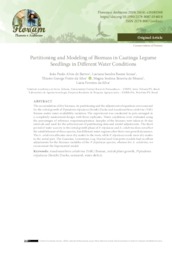Partitioning and modeling of biomass in Caatinga legume seedlings in different water conditions.
Partitioning and modeling of biomass in Caatinga legume seedlings in different water conditions.
Author(s): BARROS, J. P. A. de; SOUZA, L. S. B.; SILVA, T. G. F. da; MOURA, M. S. B. de; SILVA, L. F. da
Summary: The accumulation of dry biomass, its partitioning and the adjustment of equations were assessed for the initial growth of Piptadenia stipulacea (Benth) Ducke and Anadenanthera colubrina (Vell.) Brenan under water availability variation. The experiment was conducted in pots arranged in a completely randomized design with three replicates. Water conditions were evaluated using the percentages of reference evapotranspiration. Samples of the biomass were taken at 10-day intervals and used for the achievement of partitioning data and model adjustments. The short period of water scarcity in the initial growth phase of P. stipulacea and A. colubrina does not affect the establishment of these species, but different water regimes alter their root growth dynamics. The A. colubrina allocates more dry matter to the roots, while P. stipulacea sends more dry matter to the aerial part. The Gaussian, Lorentzian, Log-Normal and Gompertz models had excellent adjustments for the biomass variables of the P. stipulacea species, whereas for A. colubrina, we recommend the Exponential model.
Publication year: 2019
Types of publication: Journal article
Unit: Embrapa Semi-arid Region
Observation
Some of Embrapa's publications are published as ePub files. To read them, use or download one of the following free software options to your computer or mobile device. Android: Google Play Books; IOS: iBooks; Windows and Linux: Calibre.
Access other publications
Access the Agricultural Research Database (BDPA) to consult Embrapa's full library collection and records.
Visit Embrapa Bookstore to purchase books and other publications sold by Embrapa.

